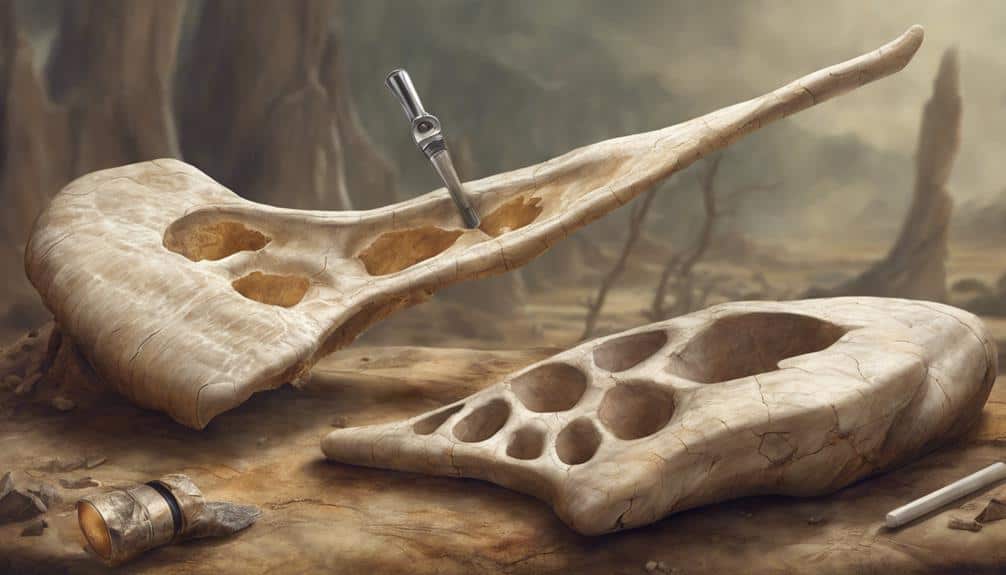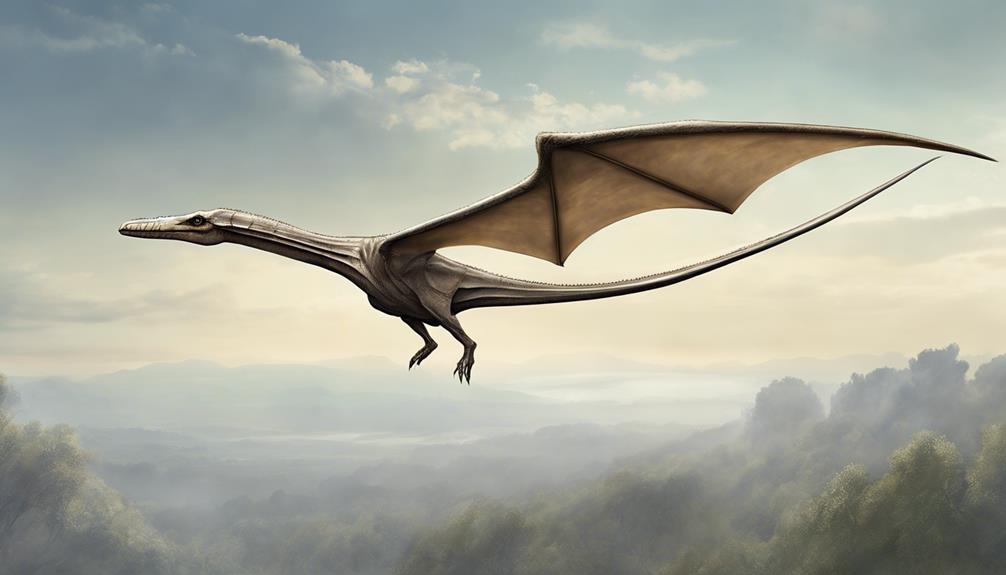Did Pterosaurs Have Hollow Bones? Imagine soaring through the Mesozoic skies, where Pterosaurs, the earliest vertebrates known for powered flight, ruled the air. This question isn’t just about prehistoric bone structure; it’s a gateway to understanding the marvels of evolution and the physics of flight. These magnificent creatures, often likened to the dinosaurs and birds, present a fascinating case study in the adaptability of life.

Did Pterosaurs Have Hollow Bones?
Yes, Pterosaurs did have hollow bones, based on analysis of fossils. This feature made their skeletons light yet strong, enabling the incredible feat of powered flight. Their bones, while robust, were perfectly adapted to reduce weight without compromising on strength.
Exploring the realm of ancient winged creatures, it becomes apparent that pterosaurs were powerful flyers due to their unique anatomical features. Their hollow air-filled bones and large breastbone keeled for flight efficiency highlight the evolutionary marvels these creatures were. With fusion in skeletons providing structural integrity, and the presence of air sacs evolved for reducing weight and enhancing oxygen exchange, these creatures mastered the skies.
Their efficient respiratory systems were a testament to their adaptability, showcasing diverse lifestyles included in their ecological niches. Additionally, the elongated jaws fused with teeth or beak adaptations allowed them to exploit a wide range of food sources.
The intricacies of pterosaur anatomy further reveal how wing membranes more than skin contributed to their flying capabilities, with complex wing membranes supported by elongated finger bones. Pycnofibers aided in thermoregulation indicating that these creatures were warm-blooded, a feature that allowed them to maintain activity in various climates.
The evolution of air sacs in these beings facilitated not just flight efficiency but also buoyancy and temperature regulation. However, there remains uncertainty about take-off methods flying, suggesting a gap in our understanding of their full capabilities. The tail stabilization vane found in some species hints at the advanced control mechanisms developed for precision in flight, underscoring the sophistication of these ancient aviators.
Table of Contents
Key Takeaways
- Pterosaur bones were indeed hollow and air-filled, similar to birds.
- Their hollow bones contributed to a lightweight skeleton, aiding in flight.
- The humerus, a critical bone for flight, was notably hollow in pterosaurs.
- Hollow bones are a feature shared with birds, underscoring pterosaurs‘ adaptations for flight.
As we continue, I’ll share more about the unique traits that allowed these creatures to dominate the skies, including their remarkable skeletal adaptations. Imagine the evolutionary journey from terrestrial to aerial mastery, highlighting not just Pterosaurs but also shedding light on the diversity of life forms that shared their world.
Stick around as we explore the skies of the past, where these aerial predators thrived, and uncover the secrets of their success.
Pterosaur Bone Structure: Lightweight Architecture Meets Aerodynamic Necessity
The bone structure of pterosaurs represents a fascinating interplay between anatomical lightness and aerodynamic performance, where hollow, air-filled bones greatly reduced their body weight while maintaining strength.
This pneumaticity not only facilitated increased oxygen circulation, important for the demands of sustained flight, but also contributed to the aerodynamic efficiency gains essential for the wide range of flight behaviors observed in these ancient reptiles.
Analyzing the density and architecture of pterosaur bones provides key insights into how these creatures achieved such remarkable flight capabilities, underscoring the evolutionary necessity of lightweight yet durable skeletal structures.
Bone Density Insights
Pterosaurs exhibit an evolutionary adaptation characterized by hollow bones. hollow bones contribute to reducing overall weight. Reducing overall weight is essential for powered flight.
These creatures also possess thin-walled bones. thin-walled bones increase structural strength. Increasing structural strength is crucial for maintaining aerodynamic shape.
Advanced imaging techniques, such as CT scans, have revealed the internal architecture of these bones. The internal architecture underscores the bones’ role in aerodynamic efficiency.
Bone density adaptations in pterosaurs optimize for aerodynamic efficiency. Optimizing for aerodynamic efficiency contrasts with adaptations for terrestrial locomotion. This relationship highlights how pterosaur bone structure was pivotal for flight capability.
Aerodynamic Efficiency Gains
- Pterosaur bone structure evolved to become hollow.
- Hollow bones reduced the overall weight.
- The reduction in weight enhanced flight efficiency.
- Pterosaurs navigated the skies with agility.
- Pterosaurs achieved endurance in flight.
- Hollow bones maintained structural integrity.
- structural integrity was essential for enduring flight stresses.
- Weight reduction facilitated streamlined bodies.
- streamlined bodies improved maneuverability.
- streamlined bodies increased speed in aerial maneuvers.
- A balance between strength and lightness was achieved.
- This balance allowed for prolonged flights.
- prolonged flights did not require excessive energy consumption.
- Nature showcased ingenuity in optimizing flight capabilities.
- flight capabilities were optimized through structural innovations.
Flight Mechanics Insights: Gliding Mastery Amidst Airborne Maneuverability

The mastery of gliding and airborne maneuverability in pterosaurs is a reflection of their sophisticated flight mechanics. This was underpinned by their unique anatomical features. Hollow, air-filled bones and specialized air sacs not only reduced overall body weight but also enhanced flight energy and agility. These features enabled these creatures to perform precise aerial maneuvers with remarkable efficiency.
This discussion will explore the strategies pterosaurs employed to optimize gliding efficiency and the techniques they used to maintain maneuverability in the air. It will shed light on the evolutionary adaptations that facilitated their dominance in the Mesozoic skies.
Gliding Efficiency Strategies
Understanding the structural similarity reveals insights into pterosaurs‘ remarkable gliding efficiency and airborne maneuverability. pterosaurs‘ hollow bones share similarities with those of modern birds. This similarity provides insights into their flight capabilities. The lightweight skeletal architecture played a pivotal role in their flight dynamics. Skeletal pneumaticity was supplemented by the architecture. The presence of air sacs within hollow structures reduced their body weight. Air sacs maximized their efficiency in the air. These ancient creatures exhibited a mastery in gliding and maneuverability. Their mastery rivals that of modern avian species.
- Hollow bones were filled with air sacs.
- air sacs contributed to a significant reduction in overall body weight.
- Lightweight structures enhanced gliding efficiency.
- gliding efficiency enabled prolonged soaring with minimal energy expenditure.
- The reduction in weight facilitated exceptional control in aerial movements.
- Optimized body structure facilitated exceptional agility in aerial movements.
Air Maneuverability Techniques
Pterosaurs possessed hollow bones. hollow bones reduced weight, enhancing maneuverability.
Pterosaurs incorporated air sacs that provided buoyancy, enabling dynamic flight patterns.
Pterosaurs executed agile aerial maneuvers such as quick turns, facilitating precise adjustments essential for hunting and evasion.
These elements illustrate a sophisticated flight mechanism that underscored pterosaurs‘ evolutionary success and led to airborne dominance.
The ability to perform complex maneuvers demonstrated a balance between form and function, which were integral to pterosaurs‘ anatomy.
Research and Discoveries: Fossil Evidence Unearthing Ancient Mysteries
Recent advancements in paleontological methods have greatly enhanced our understanding of pterosaur anatomy, particularly regarding their skeletal structure.
Fossil records, meticulously analyzed using modern imaging techniques, reveal the intricate details of hollow, air-filled bones that contributed to the pterosaurs‘ remarkable flight capabilities.
This evidence not only underscores the evolutionary adaptations of these ancient creatures but also provides a clearer picture of the biomechanical strategies they employed for aerial maneuverability.
Fossil Insights on Flight
Fossil discoveries advance our comprehension of pterosaurs‘ flight mechanics. These discoveries reveal that pterosaurs‘ hollow bones were pivotal for flight. Hollow bones share a trait with modern birds. This trait enables lightweight yet powerful flight capabilities.
The integration of skeletal pneumaticity enhances airborne efficiency. Skeletal pneumaticity also underscores evolutionary ingenuity. Evolutionary ingenuity underpins pterosaurs‘ ascension.
The detailed examination of hollow bones’ internal structure provides insights into powered flight biomechanics. Micro-CT scans of bones offer invaluable insights into aerodynamics.
Evolutionary Advantage: Hollow Bones Supporting Prehistoric Dominance
The evolution of hollow bones in pterosaurs was a pivotal adaptation that greatly contributed to their aerial dominance during the Mesozoic era. These lightweight yet structurally reinforced skeletal frameworks allowed for remarkable flight efficiency and agility, enabling these creatures to exploit a variety of ecological niches.
Also, the energy efficiency provided by this anatomical feature made sure that pterosaurs could sustain prolonged periods of flight, a key factor in their success as prehistoric aviators.
Flight Efficiency Enhancement
In the realm of prehistoric aerial dominance, hollow bones in pterosaurs significantly enhanced flight efficiency. Pterosaurs possessed hollow bones, which reduced body weight. The reduction of body weight in pterosaurs led to increased energy efficiency. Large wingspans were a feature of pterosaurs, which enhanced lift and gliding capability. The enhanced lift and gliding capability allowed pterosaurs to achieve improved maneuverability in the air.
This structural adaptation enabled pterosaurs to dominate the skies by maximizing their flight potential. The balance between size and agility was achieved by pterosaurs through reducing overall mass without compromising structural integrity. This evolutionary trait was crucial for pterosaurs in enabling large wingspans, which facilitated extensive flight distances. Furthermore, superior aerial mobility was a result of pterosaurs‘ large wingspans, granting them an unparalleled ability to exploit a variety of ecological niches.
Bone Structure Benefits
- Hollow-boned pterosaurs developed a notable advantage through evolutionary adaptation.
- This advantage combined a lightweight structure with remarkable strength and agility.
- The integration of hollow bones was a pivotal evolutionary milestone.
- hollow bones enabled these creatures to excel in their aerial habitats.
- A lightweight structure notably reduced body weight.
- Reduced body weight facilitated extended flight durations and higher altitudes.
- Air-filled cavities within the bones improved oxygen circulation.
- Improved oxygen circulation supported a more efficient respiratory system.
- A more efficient respiratory system was essential for sustained flight.
- The reduced weight contributed to the pterosaurs‘ agility.
- Increased structural support from hollow bones contributed to agility.
- Agility allowed for deft maneuvering through prehistoric skies.
- These traits established pterosaurs as formidable aerial predators.
- These traits also established pterosaurs as versatile inhabitants of their ecosystems.
Cultural Legacy: Mythological Inspirations Bridging Human Imagination

The intersection between the anatomical peculiarities of pterosaurs and their portrayal in human culture offers a fascinating glimpse into the role these prehistoric creatures have played in shaping mythological narratives across civilizations.
Studies have shown that the distinctive features of pterosaurs, such as their expansive wingspans and unique skeletal structures, have served as a foundation for the creation of various legendary creatures, prominently dragons.
This synthesis of scientific understanding and mythological interpretation underscores the profound impact that pterosaurs have had on human imagination, bridging the gap between paleontological facts and cultural legacy.
Mythical Creatures and Pterosaurs
The diverse sizes and shapes of pterosaurs inspired the flying abilities of dragons. Griffins are influenced by the elongated jaws and wingspan of pterosaurs.
The Roc‘s gigantic size is reminiscent of large pterosaurs like Quetzalcoatlus. Thunderbirds reflect the powerful flying capabilities of pterosaurs.
Cultural interpretations link harpy myths to the humanoid form and pterosaurs. These connections demonstrate the influence of pterosaurs on human legends and mythical narratives.
Frequently Asked Questions
Do Pterosaurs Have Hollow Bones?
Pterosaurs, the earliest vertebrates known to have achieved powered flight, possessed hollow, air-filled bones. This anatomical adaptation minimized weight while maintaining structural strength, important for their aerial capabilities and energy efficiency.
Which Dinosaurs Had Hollow Bones?
Sauropods, theropods, and pterosaurs, key figures in Mesozoic ecosystems, possessed hollow, air-sac-laden bones. This anatomical feature facilitated oxygen circulation, contributing to their agility and ecological dominance during the dinosaur era.
Did Pterosaurs Have Keel Bones?
Pterosaurs did not possess keel bones, in contrast to birds. Their anatomy featured a large breastbone supporting flight muscles and a notarium for flight stability, showcasing an evolutionary adaptation distinct from avian species.
What Did Pterosaurs Actually Look Like?
Pterosaurs, the sky’s ancient architects, boasted a diverse array of forms, from winged titans to diminutive insectivores, revealing a complex evolutionary tapestry woven with adaptations for flight, predation, and ecological diversity.

